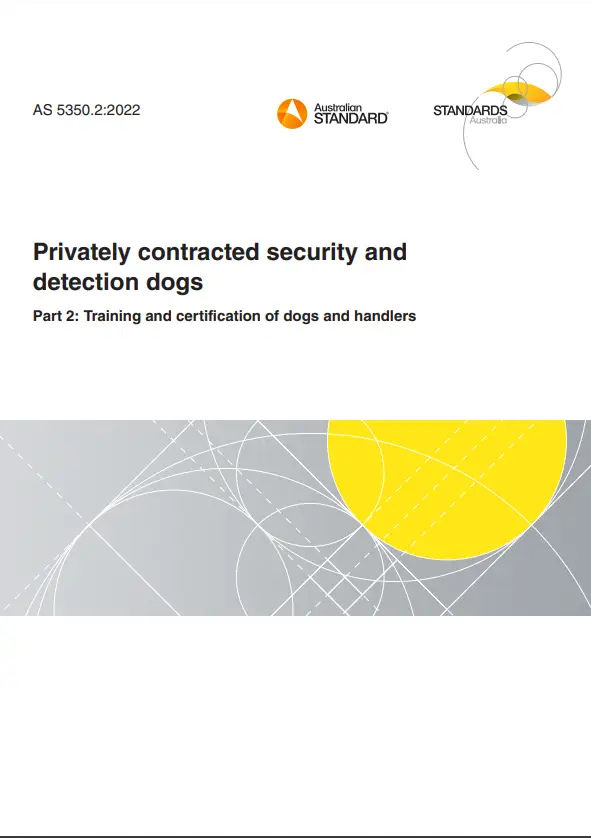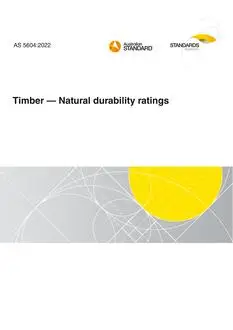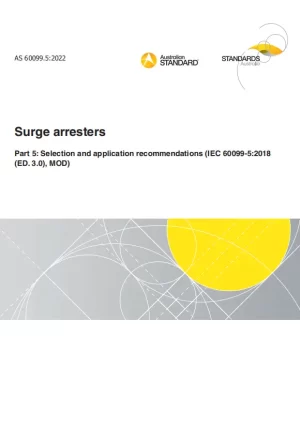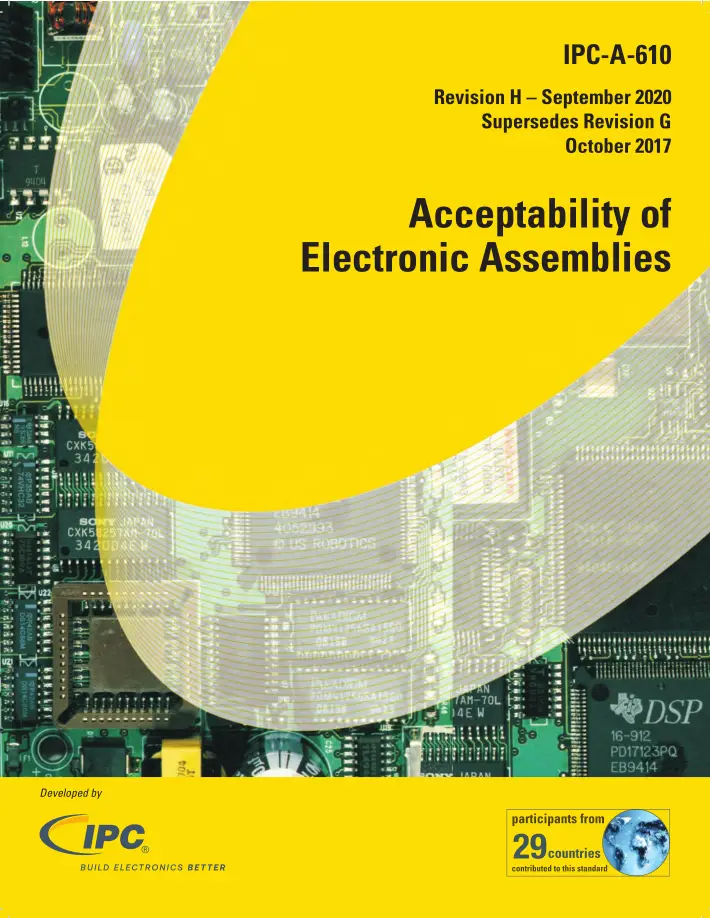Table of cotents
Preface
1 Scope and general
1.1 Scope
1.2 Application
1.3 Normative references
1.4 Terms and definitions
1.5 Certification
2 Training
2.1 General
2.2 Training and handling methods
2.3 Workplace induction training
2.4 Training records
2.4.1 General
2.4.2 Training session records for dogs
2.4.3 Training session records for handlers
2.5 Elements of competency
2.6 Accredited units of competency
2.7 Unaccredited units of competency
3 Units of competency: Initial practical assessment for handlers
3.1 General
3.2 Unit 1 — Provide basic care of domestic dogs (ACMSPE304)
3.2.1 General
3.2.2 Elements of competency and performance criteria
3.3 Unit 2 — Manage training and well-being of dogs for security functions (CPPSEC3112)
3.3.1 General
3.3.2 Elements of competency and performance criteria
3.4 Unit 3 — Condition animal behaviour (ACMBEH404)
3.4.1 General
3.4.2 Elements of competency and performance criteria
3.5 Unit 4 — Handle dogs for security patrols (CPPSEC3113)
3.5.1 General
3.5.2 Elements of competency and performance criteria
3.6 Unit 5 — Deploy detector dog (PSPBDR003)
3.6.1 General
3.6.2 Elements of competency and performance criteria
4 Units of competency: Security dog welfare and management
4.1 Unit 6 — Health and safety risk assessment
4.1.1 General
4.1.2 Elements of competency and performance criteria
4.2 Unit 7 — Daily physical examination and grooming
4.2.1 General
4.2.2 Elements of competency and performance criteria
4.3 Unit 8 — Handler training in canine first aid
4.3.1 General
4.3.2 Elements of competency and performance criteria
4.4 Unit 9 — Load, transport and unload security dogs
4.4.1 General
4.4.2 Elements of competency and performance criteria
5 Units of competency: General training for handlers of security dogs
5.1 Unit 10 — Theoretical knowledge of security dog handling
5.1.1 General
5.1.2 Elements of competency and performance criteria
5.2 Unit 11 — Heelwork
5.2.1 General
5.2.2 Elements of competency and performance criteria
5.3 Unit 12 — Recall
5.3.1 General
5.3.2 Elements of competency and performance criteria
5.4 Unit 13 — Distance control — down command with handler in sight
5.4.1 General
5.4.2 Elements of competency and performance criteria
5.5 Unit 14 — Emergency stop
5.5.1 General
5.5.2 Elements of competency and performance criteria
5.6 Unit 15 — Speak on command
5.6.1 General
5.6.2 Elements of competency and performance criteria
5.7 Unit 16 — Steadiness to noise
5.7.1 General
5.7.2 Elements of competency and performance criteria
5.8 Unit 17 — External patrol
5.8.1 General
5.8.2 Elements of competency and performance criteria
5.9 Unit 18 — Internal patrol
5.9.1 General
5.9.2 Elements of competency and performance criteria
5.10 Unit 19 — Protection work (arrest)
5.10.1 General
5.10.2 Elements of competency and performance criteria
5.11 Unit 20 — Protection work (weapon attack)
5.11.1 General
5.11.2 Elements of competency and performance criteria
5.12 Unit 21 — Searching for property
5.12.1 General
5.12.2 Elements of competency and performance criteria
5.13 Unit 22 — Searching for person(s)
5.13.1 General
5.13.2 Elements of competency and performance criteria
5.14 Unit 23 — Unauthorized entry or egress of premises
5.14.1 General
5.14.2 Elements of competency and performance criteria
6 Units of competency: General training for handlers of security dogs (detection)
6.1 Unit 24 — Operational management
6.1.1 General
6.1.2 Elements of competency and performance criteria
6.2 Unit 25 — Progression of training
6.2.1 General
6.2.2 Elements of competency and performance criteria
6.3 Unit 26 — Lead manners
6.3.1 General
6.3.2 Elements of competency and performance criteria
6.4 Unit 27 — Emergency stop and recall
6.4.1 General
6.4.2 Elements of competency and performance criteria
6.5 Unit 28 — Preparation prior to deployment
6.5.1 General
6.5.2 Elements of competency and performance criteria
7 Units of competency: Training for handlers of biosecurity detection dogs
7.1 Unit 29 — Locating identified odour — open terrain or area search
7.1.1 General
7.1.2 Elements of competency and performance criteria
7.2 Unit 30 — Indicating identified odour — open terrain or area search
7.2.1 General
7.2.2 Elements of competency and performance criteria
7.3 Unit 31 — Locating identified odour — vehicle or vessel search
7.3.1 General
7.3.2 Elements of competency and performance criteria
7.4 Unit 32 — Indicating identified odour — vehicle or vessel search
7.4.1 General
7.4.2 Elements of competency and performance criteria
7.5 Unit 33 — Safe systematic search — open terrain, area, vehicle or vessel search
7.5.1 General
7.5.2 Elements of competency and performance criteria
7.6 Unit 34 — Scent identification test
7.6.1 General
7.6.2 Elements of competency and performance criteria
8 Units of competency: Training for handlers of explosive detection dogs
8.1 Unit 34 — Scent identification test
8.2 Unit 35 — Scent awareness
8.2.1 General
8.2.2 Elements of competency and performance criteria
8.3 Unit 36 — Locating — building search
8.3.1 General
8.3.2 Elements of competency and performance criteria
8.4 Unit 37 — Locating — vehicle search
8.4.1 General
8.4.2 Elements of Competency and Performance Criteria
8.5 Unit 38 — Locating — open terrain or area search
8.5.1 General
8.5.2 Elements of competency and performance criteria
8.6 Unit 39 — Indication of explosive devices — building search
8.6.1 General
8.6.2 Elements of competency and performance criteria
8.7 Unit 40 — Indication of explosive devices — vehicle search
8.7.1 General
8.7.2 Elements of competency and performance criteria
8.8 Unit 41 — Indication — open terrain or area search
8.8.1 General
8.8.2 Elements of competency and performance criteria
8.9 Unit 42 — Safe systematic search
8.9.1 General
8.9.2 Elements of competency and performance criteria
9 Units of competency: Training in freight screening using explosive detection dogs
9.1 General
9.2 Unit 43 — Freight screening training requirements for an EDD team
9.2.1 General
9.2.2 Elements of competency and performance criteria
9.3 Unit 44 — Freight screening training requirements for an EDD
9.3.1 General
9.3.2 Elements of competency and performance criteria
9.4 Unit 45 — Freight screening training requirements for an EDD handler
9.4.1 General
9.4.2 Elements of competency and performance criteria
9.5 Unit 46 — Training conditions for EDD teams deployed to screen freight
9.5.1 General
9.5.2 Elements of competency and performance criteria
9.6 Unit 47 — Operational requirements for EDD teams deployed to screen freight
9.6.1 General
9.6.2 Elements of competency and performance criteria
10 Certification for security dog teams
10.1 Certification elements
10.1.1 General
10.1.2 Elements of competency and performance criteria for a security dog (detection) team
10.1.3 Elements of competency and performance criteria for security dog teams
10.2 Continuation training for security dog teams
10.2.1 General
10.2.2 Elements of competency and performance criteria
Appendix A
A.1 General
A.2 Veterinary records
A.3 Rest, exercise and enrichment
A.3.1 Rest
A.3.2 Exercise
A.3.3 Enrichment
A.4 Separation of handler and dog
A.5 Emergency accommodation guidelines
A.6 Retirement and rehoming
Appendix B
B.1 General
B.2 Risk assessment
B.3 Deployment records and reports
B.3.1 Records
B.3.2 Reports
B.4 Equipment
B.4.1 General
B.4.2 Canine first aid kit
B.4.3 Safety equipment and personal protective equipment
B.4.3.1 Equipment maintenance and replacement
B.4.3.2 Uniforms and identification
Appendix C
C.1 General
C.2 Management of training aides
Bibliography









